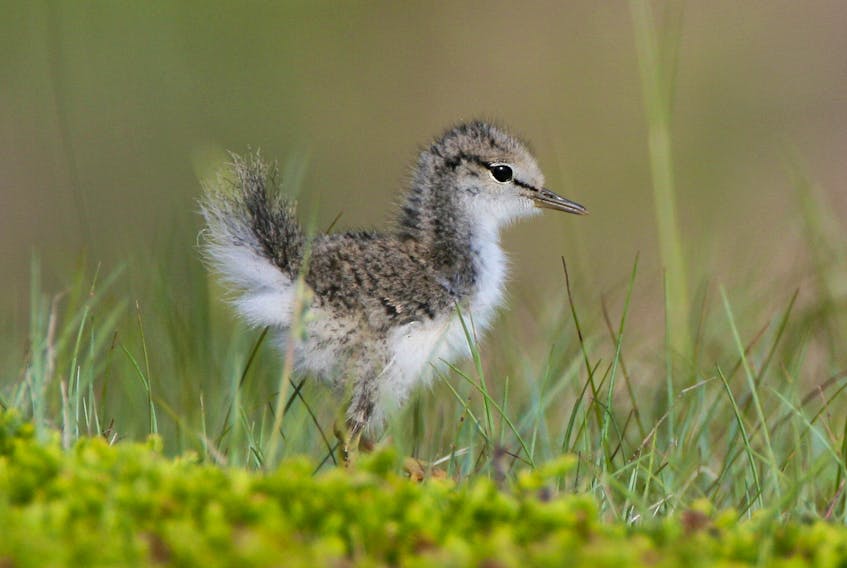Most birds have only one chance to bring off a brood of birds during the relatively short nesting season in Newfoundland and Labrador.
It was no surprise that there was a sudden flood of reports of baby spotted sandpipers in the last week. The pictures started appearing on Facebook.
Spotted sandpipers lay four eggs in a scrap on the ground hidden among vegetation usually not too far from water. The eggs take 21 days to hatch. Because the majority of spotted sandpipers arrive back in Newfoundland during the same day 10-day period in mid-May they go through the rituals of pairing up and laying eggs on the same schedule. So it is not coincidental that majority of spotted sandpiper eggs hatch during the same ten day period.

The little spotted sandpipers are more advanced than most birds when they emerge from the egg. Their eggs are relatively large to allow for extra development of the legs and feet. The little tykes are off and running as soon as they break out of the egg.
One of the adults leads the chicks away through the grass. Their feet are large and legs are strong enough to carry their nearly weightless body through the grassy jungle that will become their world for the next few weeks.
The chicks automatically know to reach for insect life clinging to the grassy blades and weed stalks. The richly vegetated areas near a pond, stream or the ocean offer a wealth of insect life.
Availability of food is not usually a problem for the tiny tots on legs. Predators such as crows, weasels, foxes, cats and dogs catch some of them. Prolonged periods of rain and cold temperature take a toll on the young sandpipers in some summers.
I came across three family groups of spotted sandpipers in the last week.
It was distress calls from the guardian adult that caught my attention before I noticed the little birds clambering away through the grass in front of me. Then a call from the adult causes the birds to freeze in their tracks. The cryptic colours break up the body shape as the puff balls blend into the grassy shadows.
They are overwhelmingly cute but should be given a wide birth when encountered so as not to stress them out too much. In couple weeks the bob-tailed youngsters will be nearly adult size and will move out to the open shoreline and beach to feed. By early September they will all be gone south again.
Bird Song Quieting
One of the sad parts of the progressing season is the quieting of bird song. The birds do not need it as much now.
The purpose of the song was to outline a nesting territory for a pair of birds. The songbirds have generally passed that stage of the nesting season. Most songbirds are feeding young in the nest or have finished nesting so there is less need for song. There are still bursts of song at day break and again in the evenings. Juncos and robins often have a second nesting in the summer and a second burst of singing during July.
American goldfinches are late nesters so are still singing in earnest. Treasure whatever snippets of song you hear during the rest of this month. Birdsong is more of a spring event. There is still lots of summer ahead!
Caplin Birds
The caplin are rolling. People have been flocking to St. Vincents beach on the southern Avalon Peninsula like never before to see the whales. I think it is all part of the staycation syndrome. Newfoundland has so much to offer in the summer time it is hard to imagine why one would really want to go elsewhere.
Birders enjoy the whales but are more focused on the seabirds. The bountiful food supply brings untold thousands of shearwaters in to land. Gannets dive in droves on the beds of caplin in deeper water.
Thousands of kittiwakes and gulls feed on the caplin that wash in on the beach or are near the surface of the water.
Birders seek out the jaegers that are drawn in from the open sea to harass the gulls and kittiwakes until they give up their capelin. The three species of jaeger look very similar to each other offering an identification challenge to even the most experienced.
Among the memorizing feeding swarms birders look for rarities. Highlights so far have been a Sabine’s gull off Cape Race and a laughing gull off St. Shotts.
Puffins, murres and razorbills join in the feeding melee.
The air is full of movement. The water is alive with birds. It is constant action for the birdwatchers.
Summer is a good time to be birdwatching.
Bruce Mactavish is an environmental consultant and avid birdwatcher. He can be reached at [email protected].









